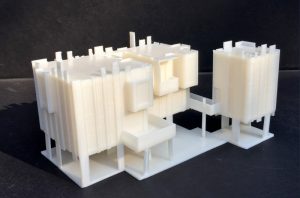
To bring architectural models to life utilizing age-old methods but more cheaply, is what we use to define 3d printing in architecture industry.
About the architecture industry
The architecture industry stems from an ideal model. Initially, the model portrays the top view of the product or the 2D image of the product that needs to be designed. The thought of 3D printing for architecture models outlines the complexities and geometrics of the planning.
On the flip side, the manual or the traditional way of designing models requires tons of effort and also conjures a considerable amount of your time. Primarily this is the reason why architects, designers, and companies like Nexgen3d are prying up on the technology and working towards 3D printing in architecture.
3D Printing in the Architecture Industry
From designing models to building objects such as lamps, sculptures, and decorative items, 3D printing has tremendous applications in the architectural sector. To begin with, 3D printing in architecture is seen to render highly detailed physical models from a variety of materials and colors as supported in the CAD model.
Irrespective of whether you are an interior designer or in the construction business, one that builds fixtures and wallpapers, or works in the backend of the designing sector, 3D printing promises excellent applications. A fascinating example here is MATT Architecture in London. It is a studio that used 3D printing technology to print ceramic tiles required in building facades.
Nexgen3d is one of the pathbreakers in the sector crafting jaw-dropping designs using 3D printing technology. With more than 30 years of experience, we are passionate about how technology is driving the architectural sector.

The fun fact being the ease with which people can craft models and print objects is what draws the attention of the leaders. But is that enough? Simplicity, though an important part, isn’t the only reason why we and others in the industry are emphasizing the application of 3D printing technology in the architectural sector.
Taking this forward, we further highlight the top reasons why we at Nexgen3d consider 3D printing the future of the industry.
Advantages of 3D Printing Technology
Starting with building concept models to putting together entire structures, 3D printing drives the majority of operations taking place within the industry.
For one, it benefits designers and clients allowing them to change the concept model quickly and comparatively inexpensively. Experts at Nexgen3d have been using the tech to provide the client with a better understanding of what the result looks like.
Based on the projected figure, it becomes easier for them to make suggestions, and corrections beforehand. We found that doing the above increases the satisfaction level of the client while reducing our efforts which would otherwise be spent on fixing the already-designed model.
Secondly, the materials used for creating a model using 3D printers have a lesser cost with more varieties and are extremely sustainable. Nexgen3d has in-house production of filaments used for 3D printing architectural models.
Also, the 3D printing filaments that are produced commercially from recycled bottles of polyethylene terephthalate (PET); are plant-based and biodegradable. Meaning that the waste they leave can be reused which again cuts down the cost of designing and printing.
3D printing goes hand in hand with the end customer. For us, the perks of 3D printing in the architecture field are viewed in terms of the flexibility of this technology followed by the ease with which it facilitates designing models and structures.
The Real-time Application of 3D Printing in Architecture
On a global level, NASA and other institutions are devising ways to use 3D printing architecture models to create habitable structures on the Moon or Mars.
The overall idea is that NASA would send a team of robots to the destination years long before humans arrive. The team would contain a rover/collector that mines and delivers raw materials; a filament plant that converts raw materials to “filament” which would then be used by the printer.
While there are others too, we at Nexgen3d, employ a proactive approach in implementing 3D printing across different verticals of the architectural sector. With our self-manufactured 3D filaments, we facilitate the design and development of models and objects effectively and efficiently.
Ready to experience the benefits of 3D printing in architecture? Contact Nexgen 3D today to start your journey toward creating jaw-dropping designs with the help of our experts.



